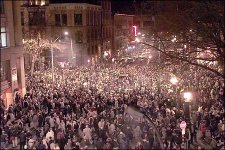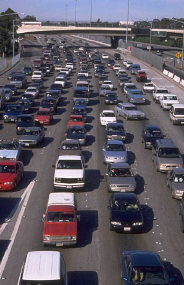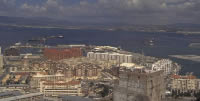ONE BILLION FOR THE ROAD
The Connection between Population Growth, Sprawl, and
Traffic Congestion
In 2003, the UN released updated global population estimates:
- the estimated world population for 2002 — 6.3 billion
- the projected world population in 2050 — 8.9 billion
Wow, that's a lot of extra people needing showers! Those people will also need a place to live,
 food to eat, water to drink, and ecosystem services to absorb and recycle the byproducts of their daily lives. For now, we'll let the worldly thinkers out there work on the problem of the globe's burgeoning masses and what ugly clothes Europe's fashion designers will come up with for them to wear.
food to eat, water to drink, and ecosystem services to absorb and recycle the byproducts of their daily lives. For now, we'll let the worldly thinkers out there work on the problem of the globe's burgeoning masses and what ugly clothes Europe's fashion designers will come up with for them to wear.
Right here in the US, we've got our own issues with population growth, and the impact is more likely to affect you than you think. Today's Eco-Logical is part 1 of a two-part series by Edwin Stennett, author of the book In Growth We Trust: Sprawl, Smart Growth, and Rapid Population Growth.
~ ~ ~
Rekindling the National Discourse on US Population Growth, pt 1 by Edwin Stennett
All politics is local
Why is the connection between US population growth and our environmental ills absent from the national discourse? Why is the call for US population stabilization only a faint echo of what it was circa 1970?
Most people don't spend a lot of time worrying about population growth or biodiversity in the ecosystem. They fret over the crime level on local streets, worry about the education of their children, and guard against environmental declines in their local streams, air, and parks. National and global issues are thought of only in abstraction; it takes a local, personal impact to motivate most people to action.
Our exploding population does have a direct effect on people's daily lives, and overpopulation is a local issue, but the connection is not always obvious to people. I've seen firsthand the glazed look that crosses a face when the issue of overpopulation is raised. But start talking about the rippling effects of overpopulation—sprawl, traffic congestion, loss of green space, crowded schools—and the same faces become engaged and energized.
Washington DC as an example
The quality of life in Washington DC is steadily declining as its population continues to increase. But the same pattern is playing out in major metropolitan areas across the country, in Atlanta, Las Vegas and Portland, to name just a few.
Like many major metropolitan areas, Washington is experiencing rapid population growth. Developed land in the Washington area nearly doubled between 1970 and 1990, and 47% of this increase was due to population growth. If the population continues to mushroom, no amount of "Smart Growth" success will prevent the destruction of hundreds of square miles of open space. The forests, meadows, and open lands that DC area residents enjoy today will vanish.
Smart Growth policies encourage development in a manner that reduces per capita land consumption. But a reduction in per capita land consumption only slows the rate
 at which we lose our open land; it does not guarantee pristine space in the future. Land "saved" in one generation will simply be lost in the next. For example, at 1997 per capita land consumption rates, Washington's urbanized area will climb to 1,800 square miles by 2025. Yet even if we could reduce per capita land consumption 25% below the 1997 rate, Washington's urbanized area would reach the same 1,800 square miles by 2063.
at which we lose our open land; it does not guarantee pristine space in the future. Land "saved" in one generation will simply be lost in the next. For example, at 1997 per capita land consumption rates, Washington's urbanized area will climb to 1,800 square miles by 2025. Yet even if we could reduce per capita land consumption 25% below the 1997 rate, Washington's urbanized area would reach the same 1,800 square miles by 2063.
Loss of green space is not the only worsening threat to Washington residents' quality of life. The area's maddening traffic congestion will continue to grow worse as the population rises—neither increased telecommuting, nor even a doubling in mass transit capacity, can prevent this.
As people go through their daily battle with clogged roads and maddening traffic, a plea grows for the government to build more roads. In the DC area, though, new roads have not proved to be an adequate solution. Over a thousand lane-miles of roads were built in the metro area between 1982 and 1999—enough freeway alone to reach from DC to Chicago. Yet congestion only became worse.
The area spent 17 years planning and constructing an expansion of Interstate 270, a major transportation corridor north of the city. By 1999, just eight years after completion, traffic loads on the widened road had already exceeded projections for the year 2010. With populations growing at such fast rates, transportation planners have no expectation of being able to keep up with the demand.
We can't pave our way out of it
Not only do cities not have the money to build roads at the rate demanded by current population growth, but there's nowhere left for potential roads
 to go. The damage to the communities bisected by new roads would be nearly as detrimental to the health of the area as more congestion. According to the Texas Transportation Institute, "The need for new roads exceeds the funding capacity and the ability to gain environmental and public approval. In many of the nation's most congested corridors there doesn't seem to be the space, money and public approval to add enough road space to create an acceptable condition."
to go. The damage to the communities bisected by new roads would be nearly as detrimental to the health of the area as more congestion. According to the Texas Transportation Institute, "The need for new roads exceeds the funding capacity and the ability to gain environmental and public approval. In many of the nation's most congested corridors there doesn't seem to be the space, money and public approval to add enough road space to create an acceptable condition."
Continuing with current levels of population growth, congestion will only get worse. In the DC area, the projected increase in the number of vehicles is a staggering 1.6 million in just 20 years. Lined up bumper to bumper, these cars would stretch from Washington to San Francisco and back again. There simply is not enough space in already dense communities to build roads to fit the huge number of cars demanded by large populations.
Population density and quality of life
"The problem of excessive population seems to be
central to nearly every problem in our state."
— George R. Ariyoshi, former Governor of Hawaii
Citizens, planners, and elected officials all need to understand how population growth works against the goal to sustain a good quality of life. Due to the US's extensive land area, some people claim there's no need to worry about our population explosion—they believe we still have plenty of land to absorb the increasing numbers.
"Our projections for 2100 will give us a population density one-quarter of the UK," said Frederick W. Holmann, a Census Bureau demographer. "We'll still be a sparsely populated country among the industrialized countries of the world." While arithmetically correct, this line of reasoning fails to consider that, unlike the UK, much of the interior US is arid and semi-arid regions, where a large percentage of the population opts not to live. The density of coastal regions far
 exceeds the density of interior regions, and we would be foolish to think this pattern will change.
exceeds the density of interior regions, and we would be foolish to think this pattern will change.
In considering how many people a land area can support, we must take into consideration the quality of life of its inhabitants. If a majority of people prefer to live in coastal cities, we must factor that preference into future overcrowding projections. We can't ignore the building pressures of overpopulation by saying there's plenty of room, if only half of DC's residents would just move to the desert.
End of Part 1
| Edwin Stennett is author of In Growth We Trust: Sprawl, Smart Growth, and Rapid Population Growth, a book that strives to clearly and forcefully draw out the links between overpopulation and local, community-level problems. For more information about the book or to purchase it, visit this Amazon.com page. |
|
~ ~ ~
So, as we can see, people have sometimes used asphalty logic to conclude that road building can solve our traffic woes. In the next Eco-Logical, part 2 of this series looks at the relationship between population, economic growth, and jobs, and concludes with a list of practical solutions to help us defuse the US population bomb.
Other parts in this series: 1 | 2
Get Grinning Planet free via email
|


